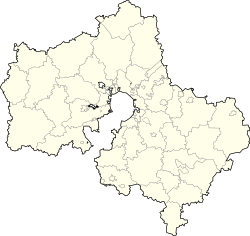Pushchino
| Pushchino (in English) Пущино (Russian) |
|
|---|---|
| - Town - | |
 Pushchino from the air |
|
 Location of Moscow Oblast in Russia |
|
|
|
|
|
|
|
| Administrative status (as of January 2013) | |
| Country | Russia |
| Federal subject | Moscow Oblast |
| Administratively subordinated to | Pushchino Town Under Oblast Jurisdiction |
| Administrative center of | Pushchino Town Under Oblast Jurisdiction |
| Municipal status (as of February 2007) | |
| Urban okrug | Pushchino Urban Okrug |
| Administrative center of | Pushchino Urban Okrug |
| Statistics | |
| Population (2010 Census) | 20,332 inhabitants |
| Time zone | MSK (UTC+03:00) |
| Known since | 16th century |
| Town status since | 1966 |
|
|
|
| on | |
Pushchino (Russian: Пущино; IPA: [ˈpuɕːɪnə]) is a town in Moscow Oblast, Russia, an important scientific center of the Russian Academy of Sciences. Situated 100 kilometers (62 mi) south of Moscow, and 13 km south-east of Serpukhov, on the right side of the Oka River opposite the Prioksko-Terrasny Nature Reserve. It is informally called Pushchino-on-Oka. Population: 20,332 (2010 Census);19,964 (2002 Census);19,479 (1989 Census).
Pushchino Research Center of Russian Academy of Sciences has unique status and significance. It hosts a major component of Russian Federation endeavor in the fields of physical, chemical, and bio-molecular biology. It employs more than 3000 people, of whom 800 hold doctorates in science or medicine. Pushchino scientists have made seminal contributions to molecular and cell biology, bio-organic chemistry, plant and soil biology, as well as to astronomy and astrophysics - including the discovery of the solar supercorona and radial magnetic fields within it, and the discovery of radio recombination lines of highly excited atoms.
The town takes its name from the village of Puschino, which was first mentioned in the 1579 records ('cadasters') of Ivan the Terrible as being a fiefdom of the Pushchin family. The modern town of Pushchino was founded in 1956 on the hill above the Oka River, some of the highest ground in Moscow Region, to host the new Radio Astronomy Observatory, an important resource that continues to contribute to mapping of space flights. This was followed by the establishment of Pushchino as a Science City, focusing on biological sciences. It was granted town status in 1966.
In the area around Pushchino there are several mesolithic, neolithic, and Bronze Age settlements. On the outskirts of modern town there is also a small Dyakovo culture Iron Age hillfort that dates back 2500 years. 1 km to the west of Pushchino on important Oka river ford in the 12th to 16th Centuries there stood the ancient Russian town of Teshilov (see), earthworks of which can be seen today.
...
Wikipedia

